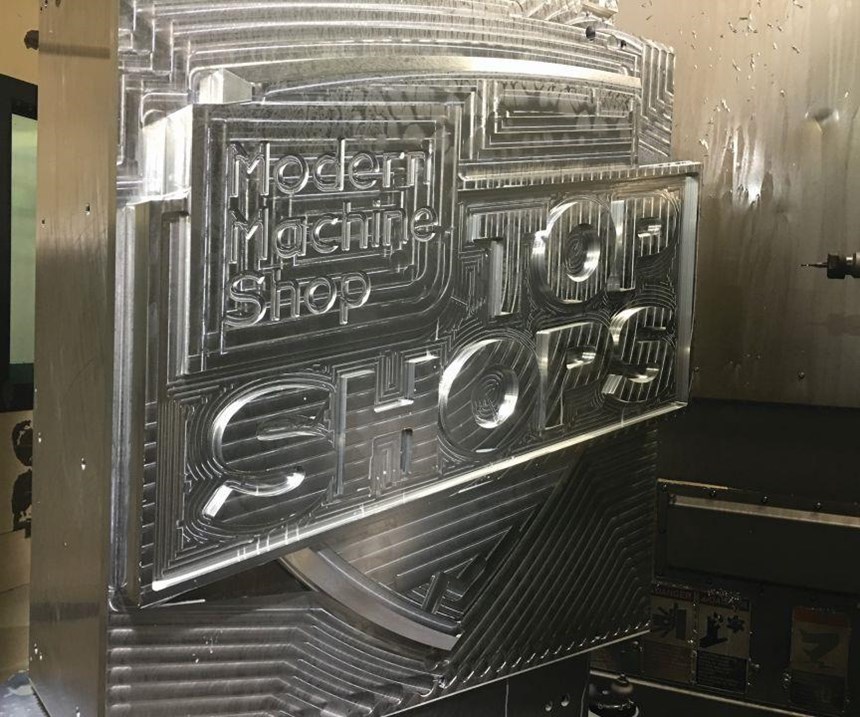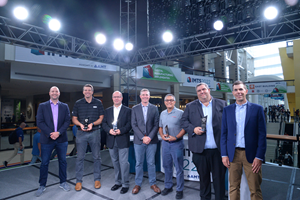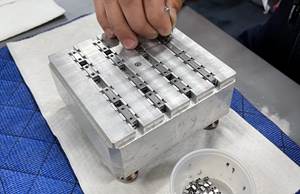Using Benchmarking to Establish a Path to Machine Shop Success
Our Top Shops benchmarking survey aims to cover everything from A to Z in identifying machine shop operational excellence and best practices. The goal is to provide shops with intelligence they can use to more effectively pave a path to success.
Much about our Top Shops benchmarking survey revolves around providing numbers and values that shops can compare to their own to see how they rate against industry leaders.
Here are three examples: In this our sixth survey edition, our Top Shops benchmarking group (the group that represents the top 20 percent of shops as determined by totaling the points assigned to certain business- and technology-related questions) reports median spindle uptime of 72 percent compared to 60 percent for other surveyed shops. Profit margins for Top Shops and other shops in 2015 were 15 and 8 percent, respectively. Plus, the quote-to-book ratio for Top Shops was 61 percent compared to 50 percent for other shops.
These and other such shopfloor and financial metrics are included in the 2016 Top Shops Executive Summary that we created. Survey participants received printed copies, but you can access a digital version at mmsonline.com/topshops.
However, what the survey also unveils are various ideas, strategies, equipment and processes that leading shops are leveraging to their advantage. Because we want the survey to cover everything from A to Z in that regard, here are 26 examples to consider based on the 2016 results:
Apprenticeship programs. A larger number of Top Shops have developed some flavor of in-house training or apprenticeship program for prospects. In some cases, a general shop training curriculum is adequate, but sometimes customization is necessary for shops having specialized machining and manufacturing processes. This type of training also helps to standardize processes, eliminating any person-to-person variation from the way the tasks are supposed to be performed.
Ballbar inspection. Circular ballbar tests give shops a diagnostic review of a machine’s capability, identifying issues such as scaling mismatch resulting from the difference in the measured travels of the X and Y axes. (Typically, one of the axes is either over-traveling or under-traveling relative to the other.) A new value for the linear error compensation parameter can then be entered to improve machining of curves and arcs.
Customer tours. Leading shops use customer tours as a marketing tool to showcase their in-house technologies and capabilities, as well as the pride they have in their employees and overall operation. Tours also enable them to demonstrate the control they have over their processes and the thought put into how work flows through the shop.
Design for manufacturability. Adding engineering staff is becoming more important for shops as more OEMs outsource their machining work. An unintended consequence of this for OEMs is that many of their product designers no longer have access to internal manufacturing engineers who can suggest ways that new designs can be modified to facilitate production. Shops that can offer DFM advice can suggest design changes to simplify machining work and reduce production costs.
Enterprise resource planning. ERP software offers potential advantages with respect to costing, estimating, scheduling and job tracking. Having fully interactive access to process control software enables supervisors to stay close to activities on the shop floor so they can quickly access pertinent information and make changes on the spot. Implementing ERP reveals actual costs and revenue where they are incurred.
Five-axis machining. Whether it’s 3+2 positioning or full contouring, many leading shops use five-axis machining as a way to create complex components with tight relative feature tolerances. Plus, accessing five faces of a part in one setup minimizes the number of times a part is touched during production.
Grinding. More than half of all surveyed shops this year refurbish cutting tools using their own grinding machines, which is a significant increase from the last survey. Although these machines are most commonly used by cutting tool manufacturers and regrinding services, simplification of operation and lower cost have made them attractive to machine shops, too.
High-speed machining. HSM was largely born out of the needs of the aerospace industry to remove a good amount of material, creating pockets from solid material as it moved away from the use of weldments. It is now being applied in other industries, whereby high spindle speeds and fast, light cuts ultimately result in higher material removal rates compared to slower hogging operations. Advanced shops use tap tests to identify the highest spindle speed that won’t result in chatter.
Indexers. A rotary indexer is a relatively inexpensive way to bring four- or five-axis motion to a three-axis VMC. It can also enable multiple parts to be fixtured, much like a tombstone on an HMC. Plus, it can be removed from a machine’s table to allow three-axis work to be performed on a large workpiece.
Just in time. Nearly 60 percent of this year’s Top Shops offer JIT delivery to customers compared to 40 percent of other shops. This isn’t surprising given the degree of process control, organizational commitment, predictive maintenance and related attributes that are required to establish an effective, reliable JIT production environment.
Kaizen events. Kaizen is the lean manufacturing concept of continuous improvement. The key to its successful implementation is making continuous improvement part of a shop’s culture, but letting individual employees determine how best to carry out kaizen. Holding large kaizen events to address significant changes is important, but it’s also important to continuously focus on what might be considered smallish improvements each day.
LinkedIn. In terms of social media channels used, LinkedIn remains the most popular among shops, compared to Facebook, Twitter and Instagram. This year, nearly 90 percent of all shops surveyed reported using it to connect and interact with potential new business contacts.
Machine monitoring. Although some Industrial Internet of Things concepts still seem ethereal at this point, machine monitoring is a real-world application shops can adopt and benefit from today. MTConnect, the open, royalty-free standard that provides a common communication link between machines, is starting to be considered by a growing number of Top Shops as a means to do that.
Near-dry machining. Also known as minimum quantity lubrication (MQL), near-dry machining delivers an oil mist instead of flood coolant to the tool and workpiece. It can lower machining costs by eliminating not only the large volume of coolant used in conventional wet operations, but also all the ancillary equipment and electrical power necessary to maintain a big, central coolant system. MQL also creates a cleaner, safer manufacturing environment, which is beneficial to the health of both the equipment used on the shop floor and the employees who work there.
On-machine probes. Probes mounted in a machine’s spindle can reduce setup time by establishing the true location of a workpiece fixtured on a table, which then enables the CNC to shift the coordinate system to compensate. They can also probe key machined features midway through a job for process control to minimize scrap and rework. Additionally, tool probes can help speed setups by automatically measuring tools and performing in-process tool-breakage checks.
Profit sharing. The hourly pay offered by Top Shops and other surveyed shops typically is similar. That said, leading shops are more likely to offer other benefits to entice and retain good employees. One is a profit-sharing plan, in which both the company and its employees can benefit because it spurs the workforce to look for ways to improve efficiencies, thereby improving production rates and profits.
Quality certifications. Some shops attain ISO or AS certification because it is demanded by their customers to demonstrate that they have an effective quality management system in place and firm control over their processes and procedures. However, leading shops don’t look at certification only as a task to be completed. Instead, to truly realize all the potential for process improvement, they make the principles of a standard part of their company culture.
Robotic automation. Robotic technology has come a long way, and leading shops recognize that robots offer real value in terms of unattended or lights-out machining situations. They’re also becoming easier to integrate and program, and have improved sensing capabilities. It will be interesting to see the impact that collaborative robots will have moving forward. These robots don’t need protective cages and can work safely in the same area as humans.
Swiss-type lathes. Screw machine shops were the first to adopt multifunction CNC Swiss-type lathes. Today, an increasing number of “traditional” shops are also considering this machining platform to, in some cases, produce complex parts complete, reducing setups, secondary operations and work in process.
Tool presetters. Offline measurement of tools using a presetter can go a long way toward reducing change-over times. This is especially important for job shops that commonly have a high mix of work. Measuring and providing tools to operators prior to subsequent new jobs eliminates the need for them to find necessary tooling themselves and manually touch-off during setup, ultimately improving spindle uptime.
Uphill battles. This year’s survey included an open-ended question asking about what shops envision to be their challenges ahead. The four most common responses were uncertainty with regard to the upcoming U.S. presidential election, concerns about the economy in general, the ebb in the oil/gas industry and the challenge of finding shopfloor talent. The last of these has been a problem for some time.
Value stream mapping. VSM is a visual lean manufacturing tool that identifies where value is or isn’t being added as material flows through a production process. The first step is to create a current-state map that shows wasted motion, unnecessary part handling and so on. Then, a future-state map can be created to show how rearranged equipment and processes can improve product flow.
Waterjet machining. Waterjets are not just for fabrication shops. An increasing number of machine shops are using them, too. One way these shops benefit from them is creating workpiece blanks from plate material to closer-to-net shape than a typical sawn blank. This reduces the amount of subsequent milling work required to complete the parts.
X factor. An X factor is a technology that shops aren’t currently implementing on a grand scale, but that could potentially enable them to diversify and/or increase efficiencies. Perhaps the biggest at this point is additive manufacturing. Still largely used for prototyping, AM can be employed to quickly 3D print tooling, fixtures, jigs and related items for use in a machine shop.
YouTube. While LinkedIn is popular among Top Shops for connecting with others, they also use YouTube to share video of their overall capabilities, specific challenging machining operations and so on. Technology such as GoPro cameras mounted inside a machine’s workzone greatly simplifies this.
Zero-point clamping systems. Many workholding device manufacturers offer zero-point clamping systems. These systems use fixtures that have a clamping knob(s) that is inserted into receivers installed on a machine’s bed. This provides quick and position-repeatable clamping. That said, there are other forms of quick-change devices for mills and lathes, as well as tooling to consider.
Three Final Points
Harbour Results Inc., is an industrial management consulting firm located in Southfield, Michigan. We asked consultant James Murphy and the HRI team to review Top Shops data to identify specific practices or strategies that leading shops share. In doing so, three ideas emerged. First, investing in technology can positively impact a shop’s bottom line. HRI has found that companies with a capital expenditure of more than 10 percent of revenue tend to be more profitable by four percentage points on average. Second, shops with an apprenticeship program have shorter machine setup times and higher capacity utilization. Third, continuous improvement initiatives result in fewer quality issues, higher on-time delivery rates and higher spindle utilization rates.
Read Mr. Murphy’s article below.
Related Content
Benchmarking: An Invaluable Business Tool
Modern Machine Shop’s Top Shops program shows shops their strengths and opportunities for improvement, and provides recognition for high-performing businesses.
Read MorePositioned to Prevail: Designing Processes Around People
Stecker Machine Company shows that getting the most value from employees means valuing your employees.
Read MoreBuilding a Better Business: Lessons for Machine Shops From an Unexpected Source
Learning how to be a great manufacturer by listening to the insights of a different industry, homebuilding (which perhaps is not so different after all).
Read MoreNiche Work If You Can Get It: A CNC Machine Shop Crafts Its Own Destiny
The latest innovations in metalworking aren’t always related to CNC automation or robotics. For Rosenberger North America, a 2022 Top Shops Honoree, it is the company’s niche processes that create the biggest successes.
Read MoreRead Next
The Cut Scene: The Finer Details of Large-Format Machining
Small details and features can have an outsized impact on large parts, such as Barbco’s collapsible utility drill head.
Read More3 Mistakes That Cause CNC Programs to Fail
Despite enhancements to manufacturing technology, there are still issues today that can cause programs to fail. These failures can cause lost time, scrapped parts, damaged machines and even injured operators.
Read More
.jpg;width=70;height=70;mode=crop)


















.png;maxWidth=300;quality=90)


.png;maxWidth=300;quality=90)








